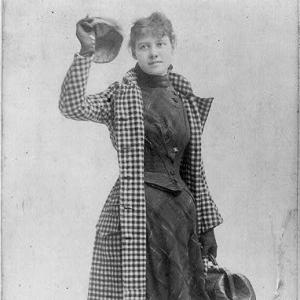1864 - 1922
By: Preston F | Date Added:

In 1887, Elizabeth Cochrane stormed into the office of the New York World, one of the leading newspapers in the country. She expressed interest in writing a story on the immigrant experience in the United States. Although, the editor declined her story he challenged Cochrane to investigate one of New York’s most notorious mental hospitals. Cochrane not only accepted the challenge, she decided to feign mental illness to gain admission and expose how patients were treated. With this courageous and bold act Cochrane cemented her legacy as one of the foremost female journalists in history. Elizabeth Jane Cochran was born on May 5th, 1864. Her family owned a lucrative mill in Cochran, Pennsylvania. At the age of six, Cochrane lost her father. Unable to maintain the land or their house, the family moved. Her mother also remarried but later divorced due to abuse. While attending Indiana Teacher’s College, Elizabeth added an “e” to her last name becoming Elizabeth Jane Cochrane. Due to the family’s financial crisis she was unable to finish her education. No longer in school, Cochrane focused on helping her mother run a boardinghouse. One day an upset Cochrane decided to pen an open letter to the editor of the Pittsburgh Dispatch. Her short but important piece pointed out the paper’s negative representation of women. The editor not only read Cochrane’s response, he printed her rebuttal, and offered Cochrane a job as columnist. As a newspaper writer, she took the pen name Nellie Bly. Although, Cochrane was a popular columnist she was often asked to write pieces that only addressed women. Wanting to write pieces that addressed both men and women, Cochrane began looking for a paper that would allow her to write more serious work. In 1896, she moved to New York City. As a woman, Cochrane found it extremely hard for her to find work. After pretending to be mentally ill for 10 days, the New York World published Cochrane’s articles about her time in the insane asylum on Blackwell’s Island was published in a six-part series. Ten Days in a Mad-House quickly made Cochrane one of the most famous journalists in the United States. Furthermore, her hands-on approach to stories developed into a practice now called investigative journalism. Cochrane’s successful career reached new heights when she decided to travel around the world after reading the popular book Around the World in 80 Days. Her trip only took 72 days, which was a world record. Cochrane would only hold it for a few months. In 1895, Cochrane married millionaire Robert Seamen and retired from journalism. Cochrane’s husband died in 1903 leaving her in control of a massive manufacturing company. In business, her curiosity and independent spirt flourished. Cochrane went on to patent several inventions related to oil manufacturing, many of which are still used today. In her later years Cochrane returned to journalism, covering the woman suffrage movement and World War I. While still working as a writer Cochrane died from pneumonia on January 27th, 1922.
click hereShare your thoughts on this story with us. Your comments will not be made public.
Email
Copyright ©2016 - Design By Bureau Blank